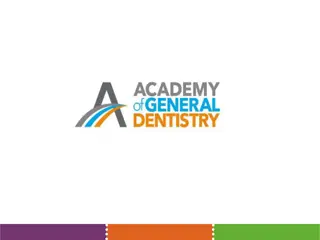Class II Cavity Preparation in Operative Dentistry
Class II cavity preparation in operative dentistry involves several key steps like occlusal outline form, proximal outline form, and resistance form. It aims to remove caries and faults while conserving tooth structure and providing sufficient support for restorative material like amalgam. Proper outlining and shaping of the cavity is crucial to ensure long-term success of the restoration.
Download Presentation

Please find below an Image/Link to download the presentation.
The content on the website is provided AS IS for your information and personal use only. It may not be sold, licensed, or shared on other websites without obtaining consent from the author.If you encounter any issues during the download, it is possible that the publisher has removed the file from their server.
You are allowed to download the files provided on this website for personal or commercial use, subject to the condition that they are used lawfully. All files are the property of their respective owners.
The content on the website is provided AS IS for your information and personal use only. It may not be sold, licensed, or shared on other websites without obtaining consent from the author.
E N D
Presentation Transcript
Class II cavity Class II cavity preparation preparation KaramAhmed MSc operative dentistry Lec.6
Occlusal outline form (occlusal step) The occlusal outline form of a Class II tooth preparation for amalgam is similar to that for the Class I tooth preparation.
Proximal outline form (proximal box ) The objectives for extension of proximal margins are to: Include all caries, faults, or existing restorative material. Establish (ideally) not more than 0.5 mm clearance with the adjacent proximal surface facially, lingually, and gingivally
Occasionally, it is permissible not to extend the outline of the proximal box facially or lingually beyond the proximal contact to conserve tooth structure
Resistance form (1) the pulpal and gingival walls being relatively flat and perpendicular to forces directed with the long axis of the tooth (2) restricting extension of the walls to allow strong cusps and ridge areas to remain with sufficient dentin support
(3) restricting the occlusal outline form (where possible) to areas receiving minimal occlusal contact. (4) the reverse curve optimizing the strength of both the amalgam and tooth structure at the junction of the occlusal step and proximal box
(5) slightly rounding the internal line angles to reduce stress concentration in tooth structure (automatically created by bur design). (6) providing enough thickness of restorative material to prevent its fracture under mastication.
Retention form Maintaining the bur parallel to the long axis of the tooth crown creates facial, lingual, and distal walls with a slight occlusal convergence During development of the distal pit area of the preparation, extension to include any distofacial and distolingual developmental fissures radiating from the pit may be indicated.
The distal pit area (in this example) provides dovetail retention form, which may prevent mesial displacement of the completed restoration. The proximal ditch cut should be sufficiently deep into dentin (i.e., 0.5 to 0.6 mm) that retention locks, if deemed necessary, can be prepared into the axiolingual and axiofacial line angles without undermining the proximal enamel.
Secondary resistance and retention forms Secondary resistance form in final tooth preparation involves both resistance of the remaining tooth structure against fracture from oblique forces and resistance of restorative material against fracture.
The occlusal convergence of the facial and lingual walls and the dovetail design (if needed) provide sufficient retention form to the occlusal portion of the tooth preparation. To enhance retention form of the proximal portion, proximal locks may be indicated to counter proximal displacement
Finishing external walls Use the mesial gingival margin trimmer to establish a slight cavosurface bevel at the gingival margin When the gingival margin is positioned gingival to the cementoenamel junction (CEJ) on the tooth root, the bevel is not indicated.
Box-only preparation When restoring a small, cavitated, proximal lesion in a tooth with neither occlusal fissures nor a previously inserted occlusal restoration, a proximal box preparation without an occlusal step has been recommended.
To maximize retention, preparations with facial and lingual walls that almost oppose each other are recommended. As in the typical preparation, the facial and lingual proximal walls converge occlusally Retention locks are necessary in box-only preparations .























